Business Economics: Exploring Demand Elasticity and the Monopoly Model
VerifiedAdded on 2023/04/20
|9
|2137
|496
Homework Assignment
AI Summary
This assignment delves into key concepts in business economics, starting with an examination of the specific demand determinants for university education in Australia by international students, highlighting factors such as global recognition, diversity, technology, and cost of living. It then explores the price elasticity of demand for alcohol, cigarettes, and cars, referencing research from 2017-2018 and discussing how price changes impact demand based on consumer behavior and market dynamics. The assignment further analyzes the potential consequences of the Northern Territory's minimum alcohol pricing policy, predicting a decline in demand due to affordability issues and shifts in consumer preferences. Finally, it discusses the monopoly model, explaining profit-maximization behavior and how firms in monopolistic markets may neglect production efficiency, leading to higher prices for consumers. The analysis references relevant studies and economic principles to support its conclusions.
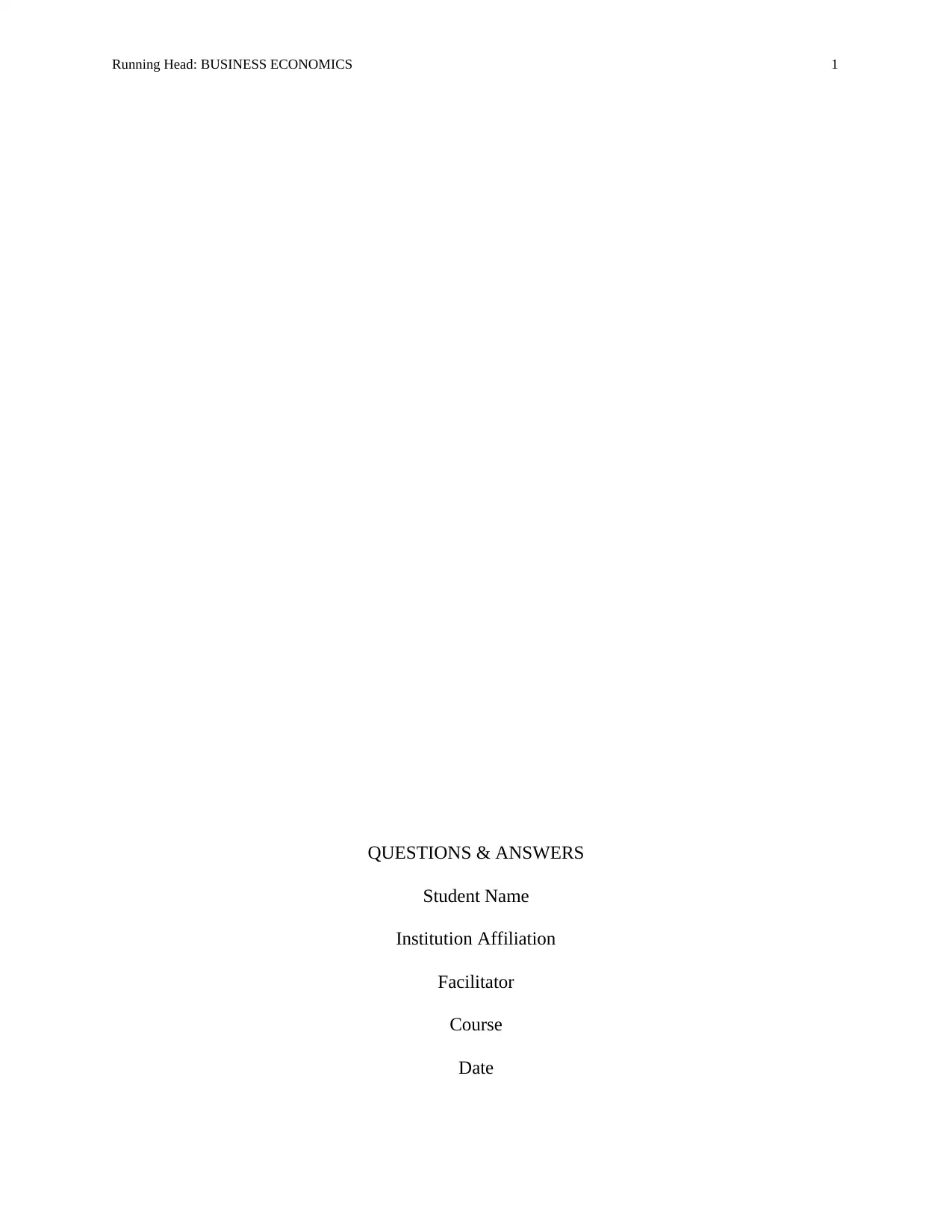
Running Head: BUSINESS ECONOMICS 1
QUESTIONS & ANSWERS
Student Name
Institution Affiliation
Facilitator
Course
Date
QUESTIONS & ANSWERS
Student Name
Institution Affiliation
Facilitator
Course
Date
Paraphrase This Document
Need a fresh take? Get an instant paraphrase of this document with our AI Paraphraser
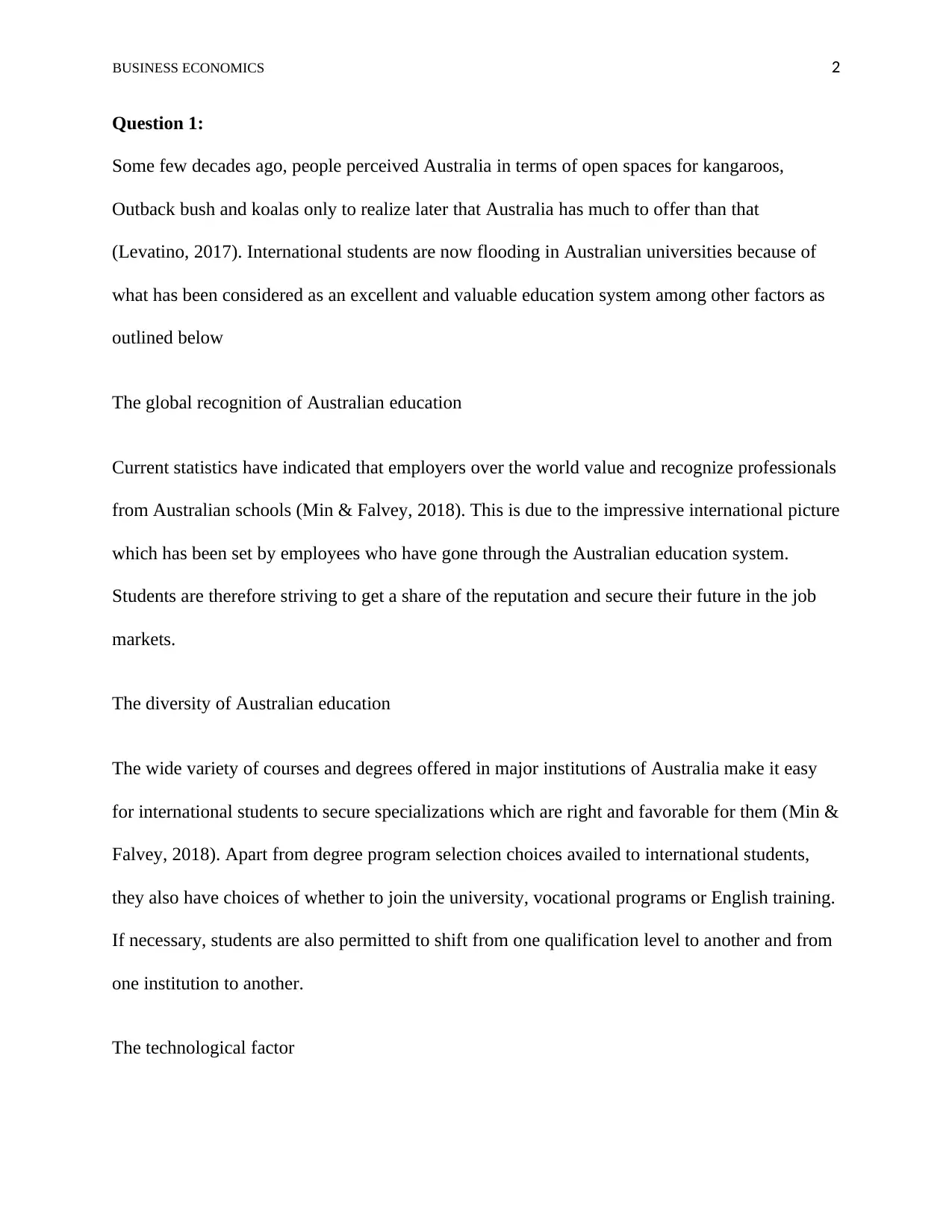
BUSINESS ECONOMICS 2
Question 1:
Some few decades ago, people perceived Australia in terms of open spaces for kangaroos,
Outback bush and koalas only to realize later that Australia has much to offer than that
(Levatino, 2017). International students are now flooding in Australian universities because of
what has been considered as an excellent and valuable education system among other factors as
outlined below
The global recognition of Australian education
Current statistics have indicated that employers over the world value and recognize professionals
from Australian schools (Min & Falvey, 2018). This is due to the impressive international picture
which has been set by employees who have gone through the Australian education system.
Students are therefore striving to get a share of the reputation and secure their future in the job
markets.
The diversity of Australian education
The wide variety of courses and degrees offered in major institutions of Australia make it easy
for international students to secure specializations which are right and favorable for them (Min &
Falvey, 2018). Apart from degree program selection choices availed to international students,
they also have choices of whether to join the university, vocational programs or English training.
If necessary, students are also permitted to shift from one qualification level to another and from
one institution to another.
The technological factor
Question 1:
Some few decades ago, people perceived Australia in terms of open spaces for kangaroos,
Outback bush and koalas only to realize later that Australia has much to offer than that
(Levatino, 2017). International students are now flooding in Australian universities because of
what has been considered as an excellent and valuable education system among other factors as
outlined below
The global recognition of Australian education
Current statistics have indicated that employers over the world value and recognize professionals
from Australian schools (Min & Falvey, 2018). This is due to the impressive international picture
which has been set by employees who have gone through the Australian education system.
Students are therefore striving to get a share of the reputation and secure their future in the job
markets.
The diversity of Australian education
The wide variety of courses and degrees offered in major institutions of Australia make it easy
for international students to secure specializations which are right and favorable for them (Min &
Falvey, 2018). Apart from degree program selection choices availed to international students,
they also have choices of whether to join the university, vocational programs or English training.
If necessary, students are also permitted to shift from one qualification level to another and from
one institution to another.
The technological factor
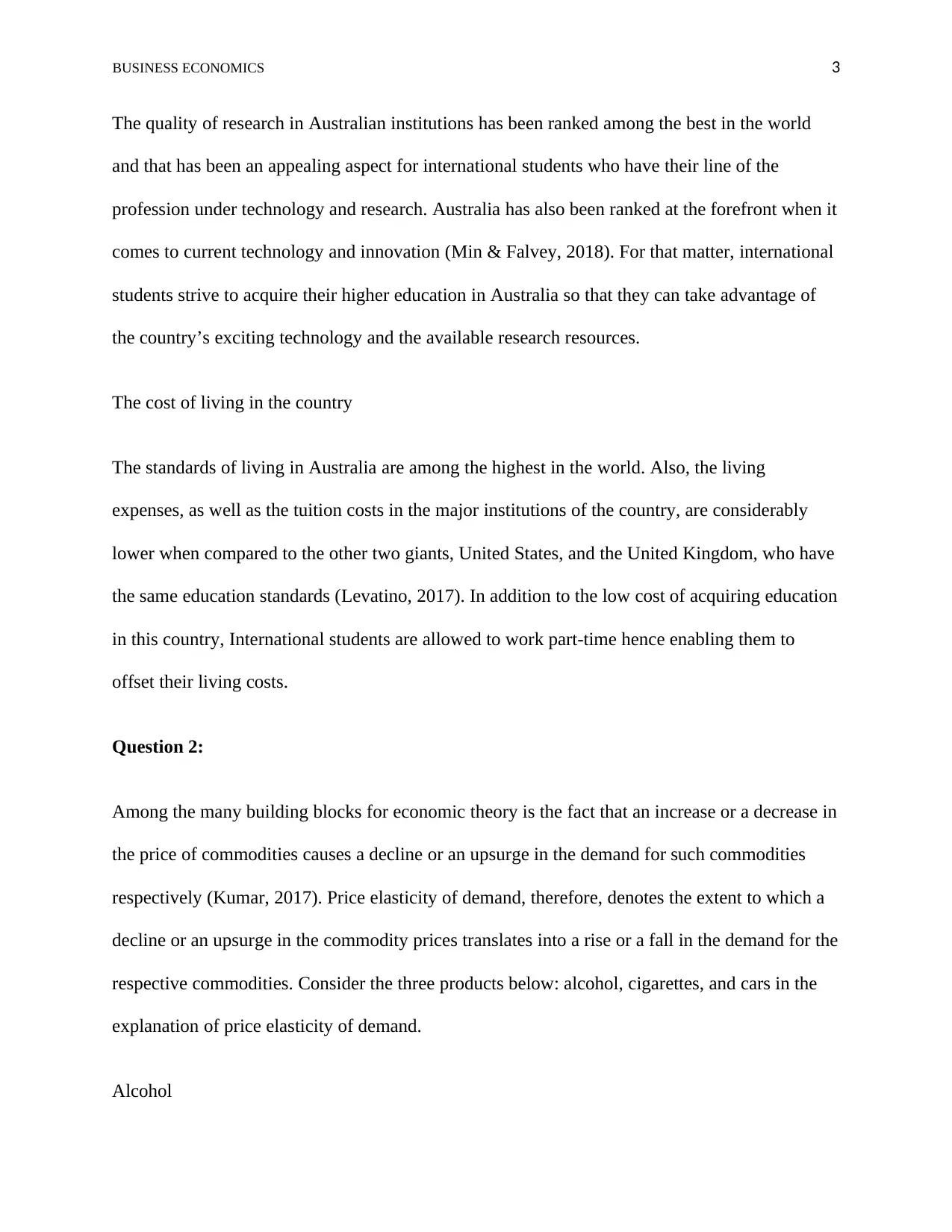
BUSINESS ECONOMICS 3
The quality of research in Australian institutions has been ranked among the best in the world
and that has been an appealing aspect for international students who have their line of the
profession under technology and research. Australia has also been ranked at the forefront when it
comes to current technology and innovation (Min & Falvey, 2018). For that matter, international
students strive to acquire their higher education in Australia so that they can take advantage of
the country’s exciting technology and the available research resources.
The cost of living in the country
The standards of living in Australia are among the highest in the world. Also, the living
expenses, as well as the tuition costs in the major institutions of the country, are considerably
lower when compared to the other two giants, United States, and the United Kingdom, who have
the same education standards (Levatino, 2017). In addition to the low cost of acquiring education
in this country, International students are allowed to work part-time hence enabling them to
offset their living costs.
Question 2:
Among the many building blocks for economic theory is the fact that an increase or a decrease in
the price of commodities causes a decline or an upsurge in the demand for such commodities
respectively (Kumar, 2017). Price elasticity of demand, therefore, denotes the extent to which a
decline or an upsurge in the commodity prices translates into a rise or a fall in the demand for the
respective commodities. Consider the three products below: alcohol, cigarettes, and cars in the
explanation of price elasticity of demand.
Alcohol
The quality of research in Australian institutions has been ranked among the best in the world
and that has been an appealing aspect for international students who have their line of the
profession under technology and research. Australia has also been ranked at the forefront when it
comes to current technology and innovation (Min & Falvey, 2018). For that matter, international
students strive to acquire their higher education in Australia so that they can take advantage of
the country’s exciting technology and the available research resources.
The cost of living in the country
The standards of living in Australia are among the highest in the world. Also, the living
expenses, as well as the tuition costs in the major institutions of the country, are considerably
lower when compared to the other two giants, United States, and the United Kingdom, who have
the same education standards (Levatino, 2017). In addition to the low cost of acquiring education
in this country, International students are allowed to work part-time hence enabling them to
offset their living costs.
Question 2:
Among the many building blocks for economic theory is the fact that an increase or a decrease in
the price of commodities causes a decline or an upsurge in the demand for such commodities
respectively (Kumar, 2017). Price elasticity of demand, therefore, denotes the extent to which a
decline or an upsurge in the commodity prices translates into a rise or a fall in the demand for the
respective commodities. Consider the three products below: alcohol, cigarettes, and cars in the
explanation of price elasticity of demand.
Alcohol
⊘ This is a preview!⊘
Do you want full access?
Subscribe today to unlock all pages.

Trusted by 1+ million students worldwide
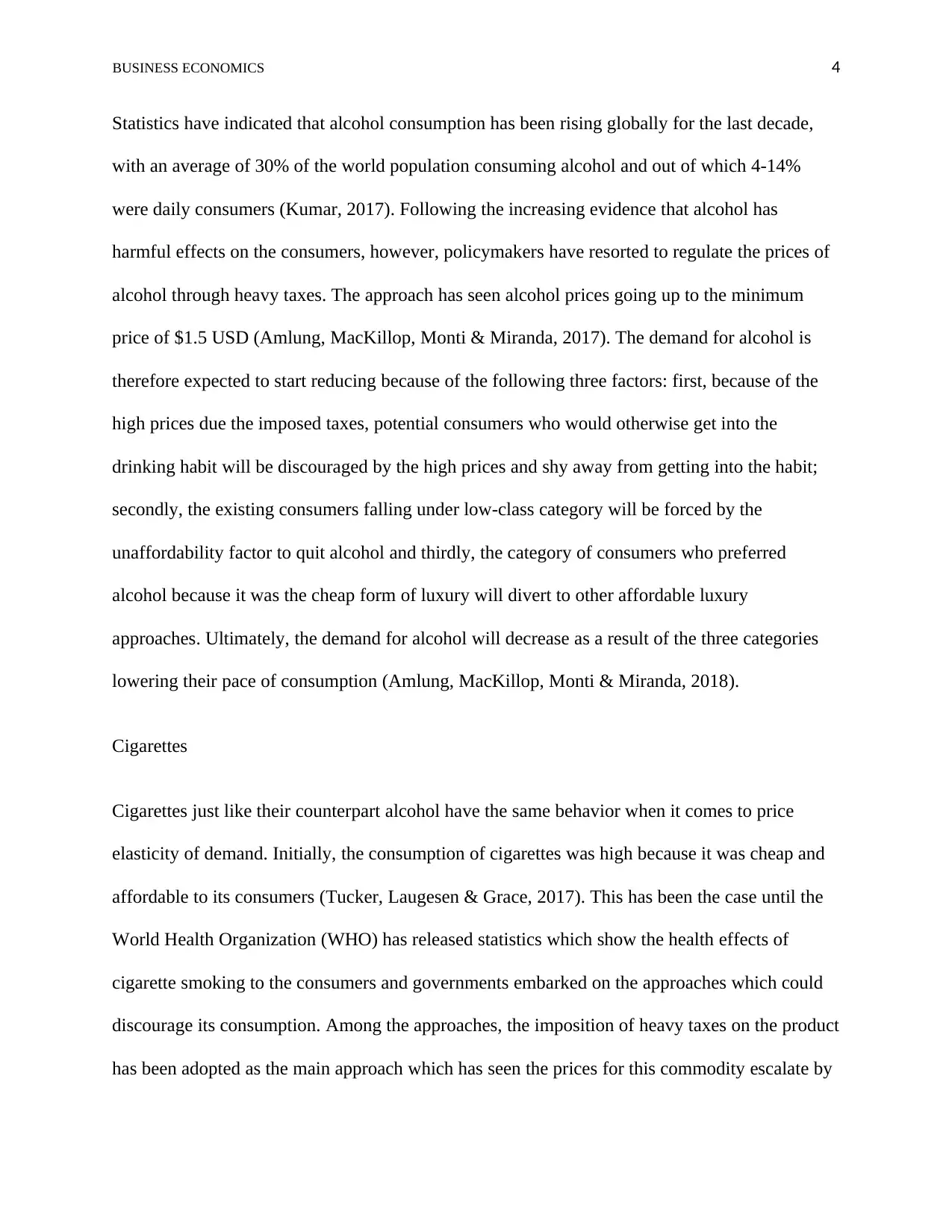
BUSINESS ECONOMICS 4
Statistics have indicated that alcohol consumption has been rising globally for the last decade,
with an average of 30% of the world population consuming alcohol and out of which 4-14%
were daily consumers (Kumar, 2017). Following the increasing evidence that alcohol has
harmful effects on the consumers, however, policymakers have resorted to regulate the prices of
alcohol through heavy taxes. The approach has seen alcohol prices going up to the minimum
price of $1.5 USD (Amlung, MacKillop, Monti & Miranda, 2017). The demand for alcohol is
therefore expected to start reducing because of the following three factors: first, because of the
high prices due the imposed taxes, potential consumers who would otherwise get into the
drinking habit will be discouraged by the high prices and shy away from getting into the habit;
secondly, the existing consumers falling under low-class category will be forced by the
unaffordability factor to quit alcohol and thirdly, the category of consumers who preferred
alcohol because it was the cheap form of luxury will divert to other affordable luxury
approaches. Ultimately, the demand for alcohol will decrease as a result of the three categories
lowering their pace of consumption (Amlung, MacKillop, Monti & Miranda, 2018).
Cigarettes
Cigarettes just like their counterpart alcohol have the same behavior when it comes to price
elasticity of demand. Initially, the consumption of cigarettes was high because it was cheap and
affordable to its consumers (Tucker, Laugesen & Grace, 2017). This has been the case until the
World Health Organization (WHO) has released statistics which show the health effects of
cigarette smoking to the consumers and governments embarked on the approaches which could
discourage its consumption. Among the approaches, the imposition of heavy taxes on the product
has been adopted as the main approach which has seen the prices for this commodity escalate by
Statistics have indicated that alcohol consumption has been rising globally for the last decade,
with an average of 30% of the world population consuming alcohol and out of which 4-14%
were daily consumers (Kumar, 2017). Following the increasing evidence that alcohol has
harmful effects on the consumers, however, policymakers have resorted to regulate the prices of
alcohol through heavy taxes. The approach has seen alcohol prices going up to the minimum
price of $1.5 USD (Amlung, MacKillop, Monti & Miranda, 2017). The demand for alcohol is
therefore expected to start reducing because of the following three factors: first, because of the
high prices due the imposed taxes, potential consumers who would otherwise get into the
drinking habit will be discouraged by the high prices and shy away from getting into the habit;
secondly, the existing consumers falling under low-class category will be forced by the
unaffordability factor to quit alcohol and thirdly, the category of consumers who preferred
alcohol because it was the cheap form of luxury will divert to other affordable luxury
approaches. Ultimately, the demand for alcohol will decrease as a result of the three categories
lowering their pace of consumption (Amlung, MacKillop, Monti & Miranda, 2018).
Cigarettes
Cigarettes just like their counterpart alcohol have the same behavior when it comes to price
elasticity of demand. Initially, the consumption of cigarettes was high because it was cheap and
affordable to its consumers (Tucker, Laugesen & Grace, 2017). This has been the case until the
World Health Organization (WHO) has released statistics which show the health effects of
cigarette smoking to the consumers and governments embarked on the approaches which could
discourage its consumption. Among the approaches, the imposition of heavy taxes on the product
has been adopted as the main approach which has seen the prices for this commodity escalate by
Paraphrase This Document
Need a fresh take? Get an instant paraphrase of this document with our AI Paraphraser
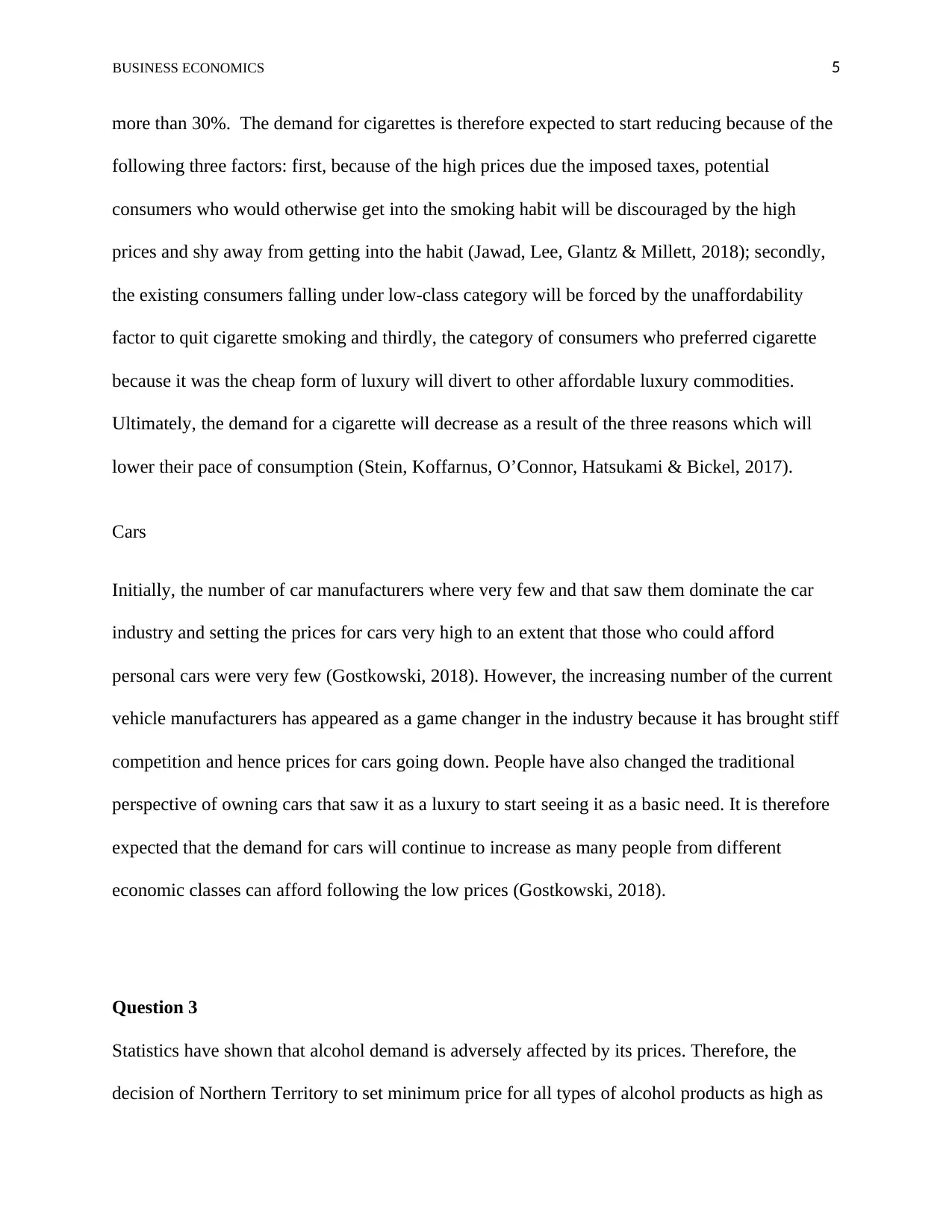
BUSINESS ECONOMICS 5
more than 30%. The demand for cigarettes is therefore expected to start reducing because of the
following three factors: first, because of the high prices due the imposed taxes, potential
consumers who would otherwise get into the smoking habit will be discouraged by the high
prices and shy away from getting into the habit (Jawad, Lee, Glantz & Millett, 2018); secondly,
the existing consumers falling under low-class category will be forced by the unaffordability
factor to quit cigarette smoking and thirdly, the category of consumers who preferred cigarette
because it was the cheap form of luxury will divert to other affordable luxury commodities.
Ultimately, the demand for a cigarette will decrease as a result of the three reasons which will
lower their pace of consumption (Stein, Koffarnus, O’Connor, Hatsukami & Bickel, 2017).
Cars
Initially, the number of car manufacturers where very few and that saw them dominate the car
industry and setting the prices for cars very high to an extent that those who could afford
personal cars were very few (Gostkowski, 2018). However, the increasing number of the current
vehicle manufacturers has appeared as a game changer in the industry because it has brought stiff
competition and hence prices for cars going down. People have also changed the traditional
perspective of owning cars that saw it as a luxury to start seeing it as a basic need. It is therefore
expected that the demand for cars will continue to increase as many people from different
economic classes can afford following the low prices (Gostkowski, 2018).
Question 3
Statistics have shown that alcohol demand is adversely affected by its prices. Therefore, the
decision of Northern Territory to set minimum price for all types of alcohol products as high as
more than 30%. The demand for cigarettes is therefore expected to start reducing because of the
following three factors: first, because of the high prices due the imposed taxes, potential
consumers who would otherwise get into the smoking habit will be discouraged by the high
prices and shy away from getting into the habit (Jawad, Lee, Glantz & Millett, 2018); secondly,
the existing consumers falling under low-class category will be forced by the unaffordability
factor to quit cigarette smoking and thirdly, the category of consumers who preferred cigarette
because it was the cheap form of luxury will divert to other affordable luxury commodities.
Ultimately, the demand for a cigarette will decrease as a result of the three reasons which will
lower their pace of consumption (Stein, Koffarnus, O’Connor, Hatsukami & Bickel, 2017).
Cars
Initially, the number of car manufacturers where very few and that saw them dominate the car
industry and setting the prices for cars very high to an extent that those who could afford
personal cars were very few (Gostkowski, 2018). However, the increasing number of the current
vehicle manufacturers has appeared as a game changer in the industry because it has brought stiff
competition and hence prices for cars going down. People have also changed the traditional
perspective of owning cars that saw it as a luxury to start seeing it as a basic need. It is therefore
expected that the demand for cars will continue to increase as many people from different
economic classes can afford following the low prices (Gostkowski, 2018).
Question 3
Statistics have shown that alcohol demand is adversely affected by its prices. Therefore, the
decision of Northern Territory to set minimum price for all types of alcohol products as high as
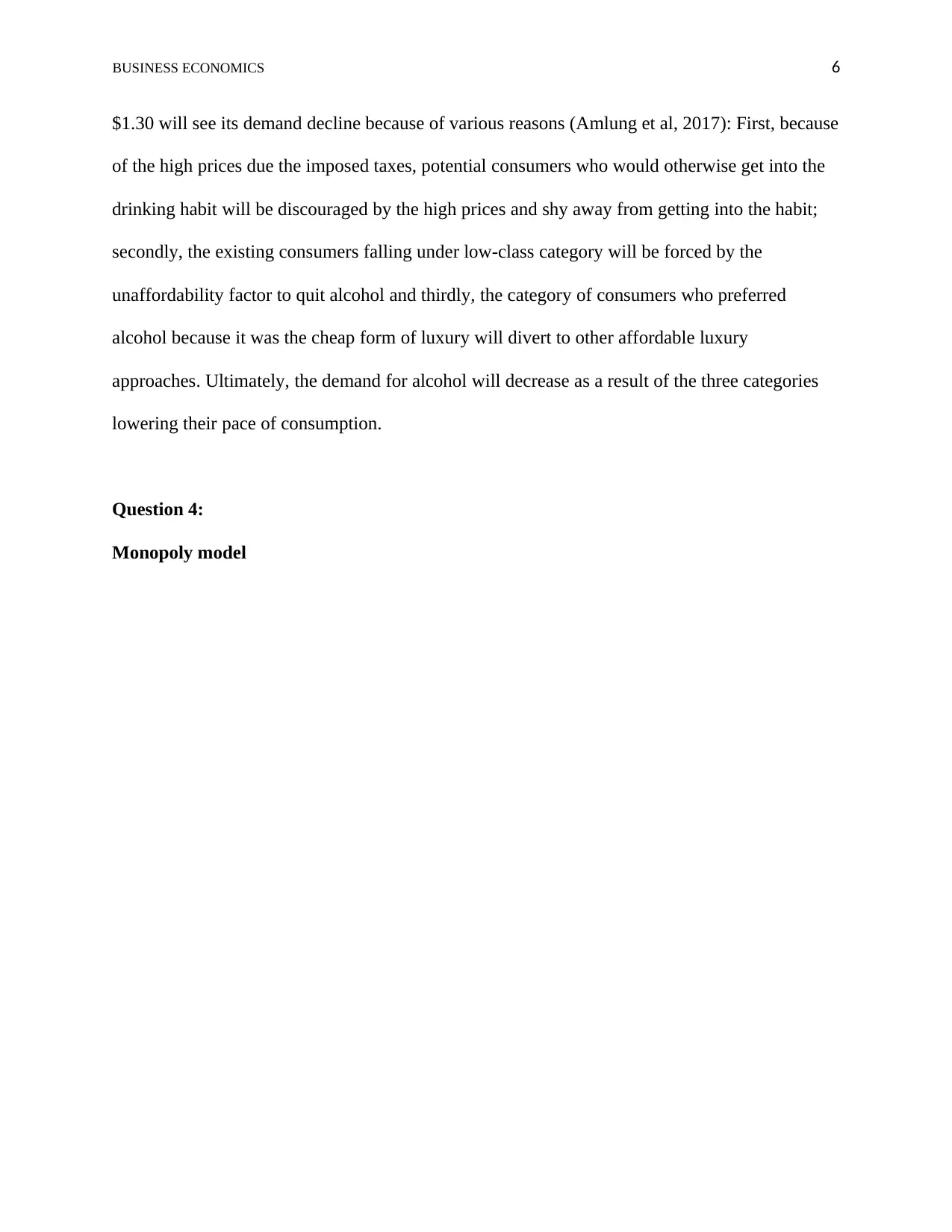
BUSINESS ECONOMICS 6
$1.30 will see its demand decline because of various reasons (Amlung et al, 2017): First, because
of the high prices due the imposed taxes, potential consumers who would otherwise get into the
drinking habit will be discouraged by the high prices and shy away from getting into the habit;
secondly, the existing consumers falling under low-class category will be forced by the
unaffordability factor to quit alcohol and thirdly, the category of consumers who preferred
alcohol because it was the cheap form of luxury will divert to other affordable luxury
approaches. Ultimately, the demand for alcohol will decrease as a result of the three categories
lowering their pace of consumption.
Question 4:
Monopoly model
$1.30 will see its demand decline because of various reasons (Amlung et al, 2017): First, because
of the high prices due the imposed taxes, potential consumers who would otherwise get into the
drinking habit will be discouraged by the high prices and shy away from getting into the habit;
secondly, the existing consumers falling under low-class category will be forced by the
unaffordability factor to quit alcohol and thirdly, the category of consumers who preferred
alcohol because it was the cheap form of luxury will divert to other affordable luxury
approaches. Ultimately, the demand for alcohol will decrease as a result of the three categories
lowering their pace of consumption.
Question 4:
Monopoly model
⊘ This is a preview!⊘
Do you want full access?
Subscribe today to unlock all pages.

Trusted by 1+ million students worldwide

BUSINESS ECONOMICS 7
Just like in any market structure, profit-maximization behavior in monopoly is based on
marginal decision rule that states that additional units of a commodity should be manufactured
provided that the marginal revenues of the additional units surpass the marginal costs. The
maximizing solution favors the situation where marginal revenues equal marginal costs. As
always, the organization efforts to maximize its profits and costs are gauged in an economic
sense of opportunity cost (Jim & Scaramozzino, 2017). The monopoly model above shows the
demand curve and its associated marginal revenue curve as faced by the monopoly firms. The
marginal cost curve slopes down over the range of output which the firms experience as
increasing marginal returns but rises when the firms began to experience diminishing marginal
Just like in any market structure, profit-maximization behavior in monopoly is based on
marginal decision rule that states that additional units of a commodity should be manufactured
provided that the marginal revenues of the additional units surpass the marginal costs. The
maximizing solution favors the situation where marginal revenues equal marginal costs. As
always, the organization efforts to maximize its profits and costs are gauged in an economic
sense of opportunity cost (Jim & Scaramozzino, 2017). The monopoly model above shows the
demand curve and its associated marginal revenue curve as faced by the monopoly firms. The
marginal cost curve slopes down over the range of output which the firms experience as
increasing marginal returns but rises when the firms began to experience diminishing marginal
Paraphrase This Document
Need a fresh take? Get an instant paraphrase of this document with our AI Paraphraser

BUSINESS ECONOMICS 8
returns. Considering the fact that these kinds of firms operate in a market structure with no stiff
competition, any efforts to maximize production are highly neglected and end up being high. To
cope with those high production costs, the firms tend to direct them into the consumer side hence
translating to high prices for their goods and services (Gilbert, 2018).
In the case study presented in this paper, the same applies to it; for instance, the air operators
may are likely to be reluctant when it comes to directing the pilots on the availability of landing
spaces in different airports which forces the planes to take too long on the air before landing.
This will automatically translate to the high operational costs of their planes and which will be
directly transferred to the consumer side hence being very expensive.
References
Amlung, M., MacKillop, J., Monti, P. M., & Miranda Jr, R. (2017). Elevated Behavioral
Economic Demand for Alcohol in a Community Sample of Heavy Drinking
Smokers. Journal of studies on alcohol and drugs, 78(4), 623-628.
Amlung, M., MacKillop, J., Monti, P. M., & Miranda Jr, R. (2018). Elevated Behavioral
Economic Demand for Alcohol in a Community Sample of Heavy Drinking
Smokers. Journal of studies on alcohol and drugs, 78(4), 623-628.
Gilbert, S. (2018). Pure Monopoly Model. In Multi-Market Antitrust Economics (pp. 15-33).
Palgrave Macmillan, Cham.
Gostkowski, M. (2018). Elasticity of Consumer Demand: Estimation Using a Quadratic Almost
Ideal Demand System. Econometrics, 22(1), 68-78.
Jim, H. S., & Scaramozzino, P. (2017). A bilateral Monopoly Model of Profit Sharing along the
Global Supply Chains. In Forum For Research in Empirical International Trade Working
Paper Series (No. 1252).
returns. Considering the fact that these kinds of firms operate in a market structure with no stiff
competition, any efforts to maximize production are highly neglected and end up being high. To
cope with those high production costs, the firms tend to direct them into the consumer side hence
translating to high prices for their goods and services (Gilbert, 2018).
In the case study presented in this paper, the same applies to it; for instance, the air operators
may are likely to be reluctant when it comes to directing the pilots on the availability of landing
spaces in different airports which forces the planes to take too long on the air before landing.
This will automatically translate to the high operational costs of their planes and which will be
directly transferred to the consumer side hence being very expensive.
References
Amlung, M., MacKillop, J., Monti, P. M., & Miranda Jr, R. (2017). Elevated Behavioral
Economic Demand for Alcohol in a Community Sample of Heavy Drinking
Smokers. Journal of studies on alcohol and drugs, 78(4), 623-628.
Amlung, M., MacKillop, J., Monti, P. M., & Miranda Jr, R. (2018). Elevated Behavioral
Economic Demand for Alcohol in a Community Sample of Heavy Drinking
Smokers. Journal of studies on alcohol and drugs, 78(4), 623-628.
Gilbert, S. (2018). Pure Monopoly Model. In Multi-Market Antitrust Economics (pp. 15-33).
Palgrave Macmillan, Cham.
Gostkowski, M. (2018). Elasticity of Consumer Demand: Estimation Using a Quadratic Almost
Ideal Demand System. Econometrics, 22(1), 68-78.
Jim, H. S., & Scaramozzino, P. (2017). A bilateral Monopoly Model of Profit Sharing along the
Global Supply Chains. In Forum For Research in Empirical International Trade Working
Paper Series (No. 1252).
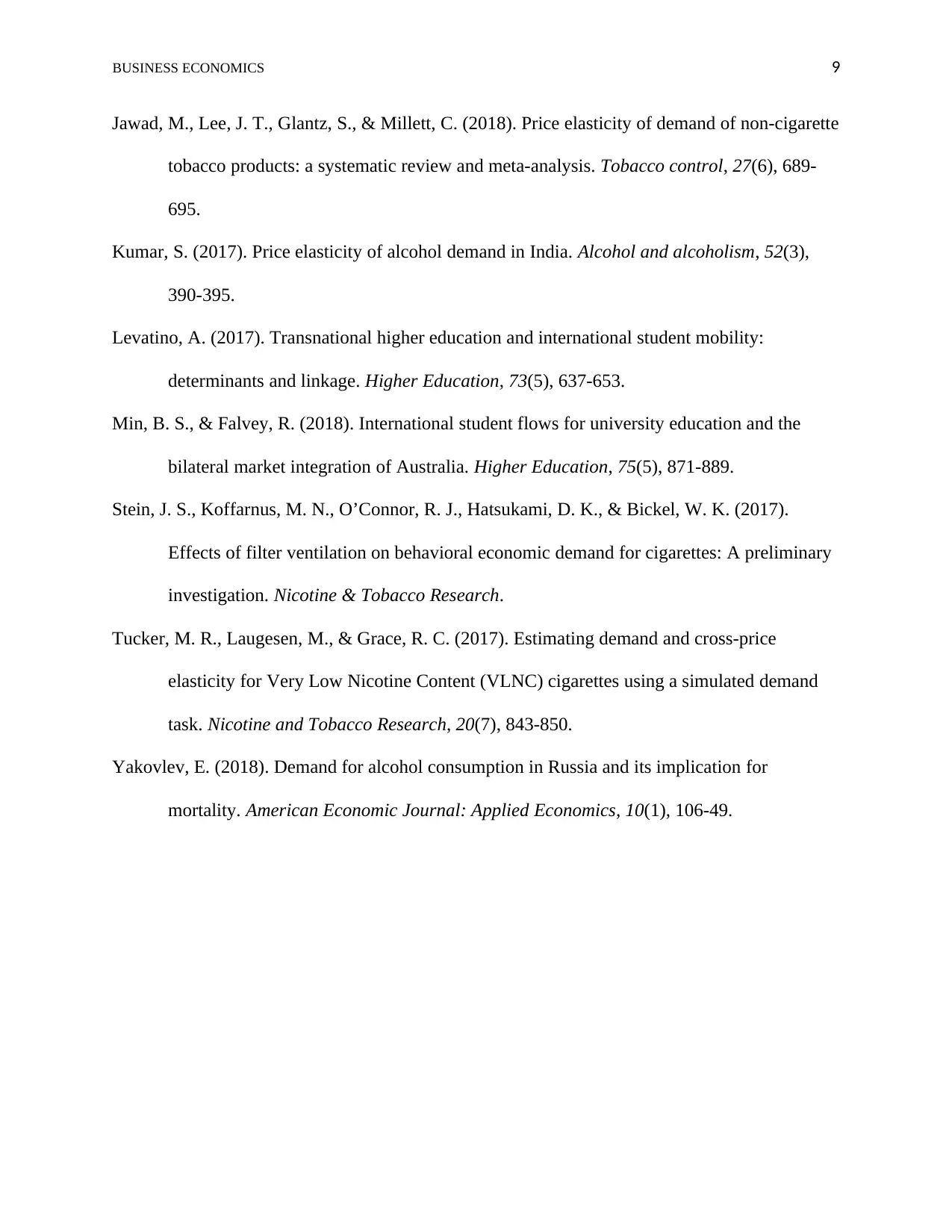
BUSINESS ECONOMICS 9
Jawad, M., Lee, J. T., Glantz, S., & Millett, C. (2018). Price elasticity of demand of non-cigarette
tobacco products: a systematic review and meta-analysis. Tobacco control, 27(6), 689-
695.
Kumar, S. (2017). Price elasticity of alcohol demand in India. Alcohol and alcoholism, 52(3),
390-395.
Levatino, A. (2017). Transnational higher education and international student mobility:
determinants and linkage. Higher Education, 73(5), 637-653.
Min, B. S., & Falvey, R. (2018). International student flows for university education and the
bilateral market integration of Australia. Higher Education, 75(5), 871-889.
Stein, J. S., Koffarnus, M. N., O’Connor, R. J., Hatsukami, D. K., & Bickel, W. K. (2017).
Effects of filter ventilation on behavioral economic demand for cigarettes: A preliminary
investigation. Nicotine & Tobacco Research.
Tucker, M. R., Laugesen, M., & Grace, R. C. (2017). Estimating demand and cross-price
elasticity for Very Low Nicotine Content (VLNC) cigarettes using a simulated demand
task. Nicotine and Tobacco Research, 20(7), 843-850.
Yakovlev, E. (2018). Demand for alcohol consumption in Russia and its implication for
mortality. American Economic Journal: Applied Economics, 10(1), 106-49.
Jawad, M., Lee, J. T., Glantz, S., & Millett, C. (2018). Price elasticity of demand of non-cigarette
tobacco products: a systematic review and meta-analysis. Tobacco control, 27(6), 689-
695.
Kumar, S. (2017). Price elasticity of alcohol demand in India. Alcohol and alcoholism, 52(3),
390-395.
Levatino, A. (2017). Transnational higher education and international student mobility:
determinants and linkage. Higher Education, 73(5), 637-653.
Min, B. S., & Falvey, R. (2018). International student flows for university education and the
bilateral market integration of Australia. Higher Education, 75(5), 871-889.
Stein, J. S., Koffarnus, M. N., O’Connor, R. J., Hatsukami, D. K., & Bickel, W. K. (2017).
Effects of filter ventilation on behavioral economic demand for cigarettes: A preliminary
investigation. Nicotine & Tobacco Research.
Tucker, M. R., Laugesen, M., & Grace, R. C. (2017). Estimating demand and cross-price
elasticity for Very Low Nicotine Content (VLNC) cigarettes using a simulated demand
task. Nicotine and Tobacco Research, 20(7), 843-850.
Yakovlev, E. (2018). Demand for alcohol consumption in Russia and its implication for
mortality. American Economic Journal: Applied Economics, 10(1), 106-49.
⊘ This is a preview!⊘
Do you want full access?
Subscribe today to unlock all pages.

Trusted by 1+ million students worldwide
1 out of 9
Related Documents
Your All-in-One AI-Powered Toolkit for Academic Success.
+13062052269
info@desklib.com
Available 24*7 on WhatsApp / Email
![[object Object]](/_next/static/media/star-bottom.7253800d.svg)
Unlock your academic potential
Copyright © 2020–2025 A2Z Services. All Rights Reserved. Developed and managed by ZUCOL.




